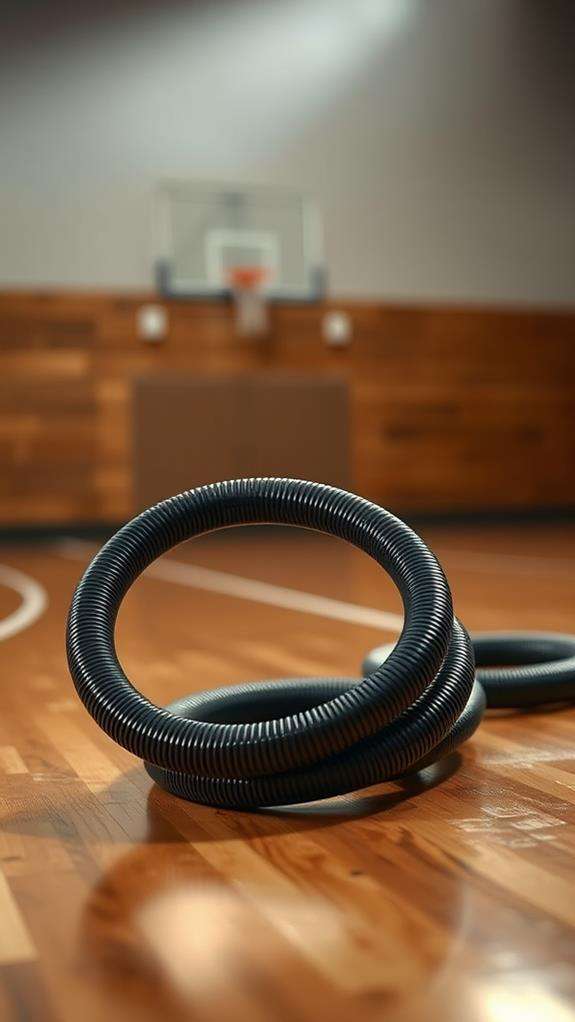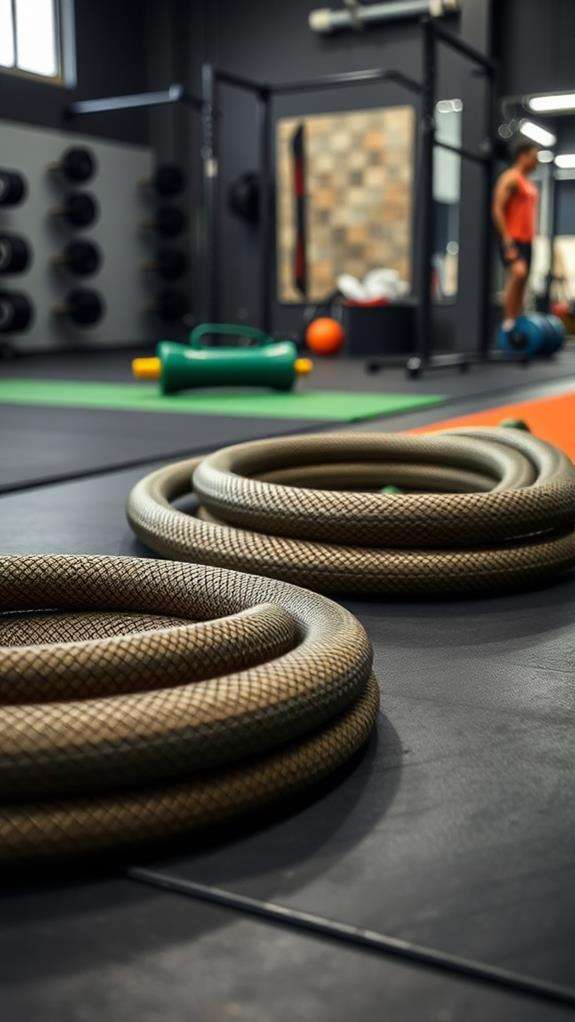Substitute for Battle Ropes
You'll find several effective alternatives to battle ropes that deliver similar full-body benefits. Medicine ball slams target comparable muscle groups while developing explosive power, while kettlebell swings engage your posterior chain for strength and cardio gains. For equipment-free options, combine burpees and mountain climbers to maintain high intensity and full-body engagement. Jump rope offers a space-efficient cardio alternative, and sledgehammer slams replicate the power-building aspects of rope training. You can also incorporate plank waves and circuit-style workouts to challenge stability and endurance. These alternatives offer varying intensity levels and workout styles to match your specific fitness goals, with plenty of ways to progress and adapt your training.
This post may contain affiliate links. If you make a purchase through these links, I may earn a commission at no additional cost to you. Additionally, portions of this post may be generated using artificial intelligence (AI) technology. While we strive for accuracy, please be aware that AI-generated content may not always be perfect and should be fact-checked when necessary.
The Spatula Scoops
- Medicine ball slams provide similar full-body engagement and explosive power development while targeting comparable muscle groups as battle ropes.
- Kettlebell swings effectively substitute battle ropes by delivering dual strength and cardio benefits while engaging the posterior chain.
- Burpees and mountain climbers offer equipment-free alternatives that maintain high intensity and full-body muscle engagement.
- Jump rope delivers high-intensity cardio training in minimal space while engaging multiple muscle groups similar to battle ropes.
- Circuit-style workouts combining explosive movements and strength exercises can replicate battle ropes' intensity and muscle engagement benefits.
Full-Body Battle Rope Alternatives

Athletes looking to replicate the intensity of battle rope workouts can turn to several powerful full-body alternatives. As a versatile training tool, medicine ball slams deliver comparable benefits by engaging your upper body while promoting explosive power development. You'll find that combining these with kettlebell swings creates a thorough workout that targets multiple muscle groups simultaneously.
When you're seeking a equipment-minimal approach, bodyweight exercises can effectively substitute for battle ropes. Incorporate burpees into your routine, as they'll challenge your cardiovascular system while working your entire body through multiple movement patterns. Mountain climbers serve as another full body alternative, allowing you to maintain an elevated heart rate while developing core strength and shoulder stability.
For those with access to cardio equipment, rowing machines provide an excellent substitute that mirrors the rhythmic, full-body engagement of battle ropes. You'll activate both your upper and lower body muscles while building endurance. To maximize your results, try alternating between high-intensity intervals on the rower and explosive movements like box jumps, creating a thorough workout that delivers comparable benefits to traditional battle rope training.
Top Equipment-Free Training Options

While specialized fitness equipment offers unique benefits, many powerful battle rope alternatives require no equipment at all. You'll find these whole body exercises can deliver the same intensity and cardiovascular benefits you'd expect from battle ropes, making them perfect for your home gym setup.
| Exercise | Battle Rope Benefits Match |
|---|---|
| Burpees | High-intensity cardio, full-body engagement |
| High Knees | Rhythmic movement, core activation |
| Shuttle Sprints | Power development, endurance training |
| Mountain Climbers | Upper body stability, core strength |
| Plyometric Moves | Explosive power, muscle engagement |
When you're looking for an alternative to battle ropes, these bodyweight exercises will challenge your cardiovascular system and build strength simultaneously. Start with burpees, which mimic the full-body engagement of rope slams, then incorporate high knees to maintain that elevated heart rate. You can intensify your workout by adding shuttle sprints in short bursts, similar to rope waves. Mountain climbers provide the continuous movement pattern you'd get from alternating rope waves, while plyometric exercises like jump squats deliver the explosive power development typically achieved with battle ropes.
Strength Building Substitute Exercises

Since battle ropes deliver exceptional strength gains, you'll need equally powerful substitutes to maintain your progress. You'll find that exercises like Medicine Ball slams offer an explosive full-body workout that targets multiple muscle groups while improving your power and coordination.
Kettlebell Swings serve as another excellent alternative, engaging your posterior chain and delivering both strength and cardiovascular benefits in one fluid movement. When you're looking to maximize your strength gains, try incorporating Barbell Thrusters, which combine squats and overhead presses for thorough muscle engagement. Your legs, core, and upper body will work together, similar to the way they do during battle rope exercises.
For raw power development, you can't go wrong with Sledgehammer Slams. This functional movement mimics the intensity of battle ropes while building strength throughout your entire body. By rotating between these exercises, you'll maintain the same level of strength development you'd achieve with battle ropes. Each movement offers unique benefits while targeting multiple muscle groups, ensuring you won't lose any of your hard-earned gains during your training sessions.
Explosive Movement Training Activities

You can effectively substitute battle ropes with powerful explosive movements that build similar strength and cardiovascular benefits through box jumps, medicine ball slams, and kettlebell swings. Your box jump training should start at a comfortable height, focusing on landing softly with bent knees while maintaining proper form throughout the movement, which develops lower body power and improves coordination. When incorporating medicine ball slams and kettlebell swings into your routine, you'll engage multiple muscle groups simultaneously, creating an intensive workout that mirrors the explosive, full-body engagement of battle rope exercises.
Power Through Box Jumps
Box jumps stand as a powerhouse substitute for battle rope training, delivering explosive strength development and cardiovascular benefits in one dynamic movement. When you engage in this challenging workout, you'll target your lower body muscles while simultaneously improving your power, agility, and overall athletic performance. Your quadriceps, hamstrings, and glutes work together to generate the explosive force needed for each jump, while your core maintains stability throughout the movement.
To maximize your box jump training, follow these essential guidelines:
- Start with a box height that allows you to land with your hips above your knees
- Drive through your heels and extend your hips fully during the jumping motion
- Land softly on the box with both feet simultaneously, absorbing impact through your legs
- Step down carefully after each jump rather than jumping down to prevent unnecessary stress
You can progressively increase the intensity of your workout by adjusting the box height, adding more repetitions, or incorporating box jumps into circuit training. Remember to maintain proper form throughout your session, focusing on controlled movements and stable landings to prevent injury while building explosive power.
Mastering Medicine Ball Slams
Through dynamic force and explosive power, medicine ball slams deliver an intense full-body workout that rivals battle rope training. Unlike battling ropes, which require a fixed anchor point, you'll find medicine ball slams offer greater flexibility in both indoor and outdoor settings, targeting similar muscle groups with explosive movements.
To master this exercise, start by selecting an appropriate weight that allows for controlled, powerful movements. Stand with your feet shoulder-width apart, raise the medicine ball overhead, then engage your entire body as you forcefully drive the ball toward the ground. You'll want to bend your knees slightly and hinge at your hips while maintaining a straight back throughout the movement. As you slam the ball, your core should remain tight and engaged.
What makes medicine ball slams particularly effective is their scalability across fitness levels. You can adjust the intensity by varying the ball's weight and your speed of execution. For beginners, start with a lighter ball and focus on form, while advanced athletes can increase both weight and tempo to create a challenging cardiovascular workout that builds power and muscular endurance simultaneously.
Kettlebell Swing Variations
Moving from medicine ball explosiveness to another powerful training tool, kettlebell swings stand as a dynamic alternative to battle ropes that builds exceptional full-body strength and power. According to Mens Health, this compound movement not only enhances grip strength but also excels at building muscle and burning fat through its high-intensity nature.
To maximize your kettlebell training, you'll want to incorporate these essential variations:
- Traditional two-handed swing – Master the fundamental hip hinge movement while engaging your posterior chain
- Single-arm swing – Challenge your core stability and improve unilateral strength
- Alternating-hand swing – Enhance coordination while maintaining continuous explosive movement
- Double kettlebell swing – Increase overall load and power output for advanced training
When performing kettlebell swings, you'll need to maintain proper form throughout each variation. Keep your back straight, hinge at your hips, and engage your core as you explosively drive the weight upward. The power should come primarily from your legs and hips, not your arms. Remember to start with lighter weights until you've mastered the movement pattern, then progressively increase the challenge as your technique improves.
Cardio And Endurance Replacements

Several effective cardio and endurance exercises can replace battle ropes while delivering similar cardiovascular benefits. You'll find that jump rope offers an excellent alternative, engaging multiple muscle groups while requiring minimal space. When you're looking to elevate your heart rate quickly, burpees provide a thorough full-body workout that matches the intensity of battle rope exercises.
| Exercise | Space Needed | Intensity Level |
|---|---|---|
| Jump Rope | Small | High |
| Burpees | Medium | Very High |
| Mountain Climbers | Small | Moderate |
Mountain climbers serve as another space-efficient option, targeting your core while maintaining an elevated heart rate throughout your workout session. You can incorporate shuttle sprints into your routine when you've got more room to move, as they'll effectively challenge your cardiovascular system and improve your agility. These exercises work together to create a well-rounded cardio routine that rivals the effectiveness of battle ropes. By combining these movements in circuit-style workouts, you'll maintain the high-intensity nature of rope training while developing both strength and endurance.
Muscle Targeting Battle Rope Swaps

Battle rope exercises target specific muscle groups that you can effectively train with alternative equipment. For those looking for nutritious meal options, consider simple recipes for healthy eating that can complement your fitness routine. As an excellent Battle Rope Alternative, you'll find that Medicine Ball Slams deliver comparable muscle engagement while offering the added benefit of controlled resistance training. When you're looking to replicate the full-body workout battle ropes provide, these targeted substitutions will help maintain your training intensity.
Consider incorporating these muscle-focused alternatives into your routine:
- Medicine Ball Slams – Target your shoulders, core, and legs through explosive movements that mirror battle rope waves
- Kettlebell Swings – Engage your posterior chain while developing power and stability through dynamic movements
- Plank Waves – Maintain core tension while moving your arms in wave-like patterns to challenge your stability
- Barbell Thrusters – Combine lower body power with upper body pressing for complete muscle engagement
You'll find these exercises particularly effective when performed in high-intensity intervals. Focus on maintaining proper form throughout each movement, especially during Kettlebell Swings and Medicine Ball Slams, where momentum can affect technique. Remember to start with lighter weights and progress gradually to prevent injury while building strength and endurance.
Frequently Asked Questions
How Do You Substitute Battle Ropes?
You can effectively replace battle ropes with several alternatives. Try medicine ball slams or kettlebell swings for similar full-body conditioning. Incorporate bodyweight exercises like burpees or high knees to maintain intensity. Use rowing machines or Airdyne bikes for thorough cardio workouts. For explosive power, add box jumps or jumping power slams to your routine. If you need a compact solution, consider using a sandrope, which offers comparable benefits.
Can You Make Your Own Battle Ropes?
Just like sailors craft their own ropes for maritime adventures, you can create your own battle ropes at home. You'll need heavy-duty nylon or polyester rope that's 1.5-2 inches thick and 30-50 feet long. Simply wrap the ends with duct tape for grip, and you're ready to go. For a creative alternative, you can fill a durable tube with sand to make an adjustable-weight rope. Don't forget to wear gloves and check regularly for wear.
What Muscle Do Battle Ropes Work?
When you're using battle ropes, you'll primarily work your front deltoids (shoulder muscles) during the swinging motions. You're also engaging your inner biceps while gripping the ropes, and your lats during pulling movements. Your core muscles stay constantly active for stability. Additionally, you'll work secondary muscle groups including your outer biceps, forearms, and both lower and upper back muscles throughout the exercise.
How to Do Battle Ropes With Dumbbells?
Stand with your feet shoulder-width apart in a squat stance, holding a dumbbell in each hand. Keep your core engaged and back straight. Start with alternating waves by raising one dumbbell up while lowering the other, creating a fluid, wave-like motion. Maintain a steady rhythm and controlled movements. You can also perform double-arm waves by raising and lowering both dumbbells simultaneously. Start with lighter weights until you master the form.





